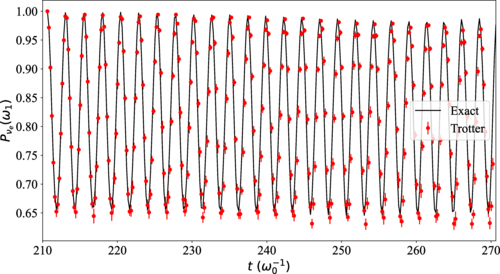We all know our little section of this thoroughfare, but it’s easy to forget we see just a glimpse of this road that ends at Yellowstone Park. Here are 14 things you never knew about Rt. 14.
Read the full article at: https://northwestchicagoland.northwestquarterly.com/2024/05/06/14-short-stories-along-route-14/News Archives
Cristian Vega awarded Callen Award for Excellence in Theoretical Plasma Physics Research
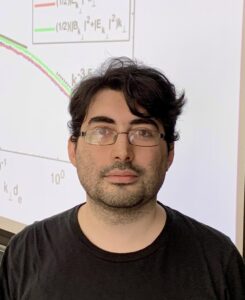
Congrats to (now) Dr. Cristian Vega who won the Callen Award for Excellence in Theoretical Plasma Physics Research! Vega won the award on April 29, just days before defending his thesis on May 3.
The Callen Award is awarded annually to a UW–Madison plasma physics graduate student for achievements in plasma theory. Now-retired Professor Emeritus Jim Callen was a long-time faculty member in the Nuclear Engineering and Engineering Physics department. Callen was also an affiliate faculty member of the Physics department.
Two physics students win presentation awards at APS April Meeting
Elias Mettner and Nadia Talbi, both conducting research in high energy physics at UW–Madison, won undergraduate presenter awards at the American Physical Society’s April Meeting.
The meeting, held in Sacramento April 3-6, included seven undergraduate oral presentation sessions with six to eight students in each session. The top two students from each session earned “Top Presenter” awards. Mettner and Talbi were the only two UW–Madison students who gave oral presentations, and both won awards.
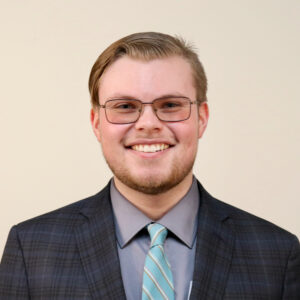
Mettner is a physics major working with scientist Abdollah Mohammadi. His talk was titled “Pair Production and Hadron Photoproduction Backgrounds at the Cool Copper Collider.”
The Cool Copper Collider is a proposed electron-positron collider that will help scientists to explore the Higgs boson even further. The electron-positron beam will have some natural decay that converts into particles and is recorded by the detector. Mettner’s research asks how this beam background will impact the detector.
“The detector will record this background, and it could take the place of the data we want or make it harder to reconstruct data,” Mettner says. “It’s important to make sure that the backgrounds that will come into the detector using this new design will not cause any issues, otherwise the benefits of this collider design cannot be put to their maximum use.”
Mettner had been interested in physics from a young age and comes from a family of teachers who encouraged him to explore his academic interests. Upon entering UW–Madison, he jumped at the chance to conduct research in particle physics. He joined the UW CMS Collaboration in his freshman year through the Undergraduate Research Scholars program and began his project with the Cool Copper Collider soon after. He was also awarded the Sophomore Research Fellowship for his junior year and the Hilldale Research Fellowship for his upcoming senior year.
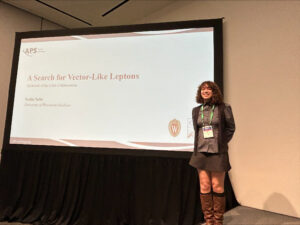
Talbi is an astronomy-physics major working in physics professor Tulika Bose’s group and mentored by postdoc Charis Koraka. Her talk, “A Search for Vector-Like Leptons: Compact Analysis,” covered work she has done through a Thaxton Fellowship.
“Bosons are force particles, and basically every boson except for the Higgs — the photon, the gluon — is a vector boson. Leptons are electrons, muons, neutrinos, stuff like that,” Talbi explains. “Vector-like leptons are a hypothetical particle, we don’t know whether or not they exist.”
Talbi was drawn to astronomy because she has long had an interest in the fundamental nature of the universe. As a child, she read an article on Dark Matter and, later, a friend gave her a book on the Standard Model. She was hooked. When she applied for the Thaxton Fellowship, a departmental program that was started to provide more equitable access to undergraduate research in physics, she discussed her interest in particle physics and the research at CERN, which landed her in Bose’s group.
“So before I even had any formal education in physics, where things can be very black and white, I’ve had the opportunity to understand the beautiful things within the field,” Talbi says. “Studying physics, I think, gives you some of the most fundamental understanding of our existence.”
Both Metter and Talbi say that attending conference was overall a very worthwhile experience — even if they both had to take an E+M exam remotely before presenting. (“It was a good bonding experience,” Talbi says.)
“The conference was a lot of fun, and worth it to go and make some connections and experience a bunch of really interesting research from people all in different stages of their careers,” Mettner says.
Adds Talbi: “There were so many undergraduates there, I met so many, I made a lot of friends. It felt like there was a community.”
Both students were also invited to present their award-winning talks to the Physics Board of Visitors spring meeting.
UW–Madison physicist Francis Halzen elected to National Academy of Sciences
Halzen directs the UW–Madison Institute for Elementary Particle Physics Research and is the principal investigator of the IceCube Neutrino Observatory.
Read the full article at: https://news.wisc.edu/uw-madison-physicist-francis-halzen-elected-to-national-academy-of-sciences/Pupa Gilbert earns undergraduate mentoring award
Congrats to Prof. Pupa Gilbert on earning an Award for Mentoring Undergraduates in Research, Scholarly and Creative Activities!
The Office of the Provost offers awards to recognize the important role mentors play in fostering undergraduates’ intellectual, personal and professional growth through participation in high-impact practices including research, scholarly and creative endeavors. These awards provide mentors with recognition for their excellence in mentoring undergraduates and their contribution to our students’ Wisconsin Experience.
Gilbert has mentored many undergraduate and graduate students as a physics professor at UW–Madison. Some of these students, like Andrii Hopanchuk ‘24, worked on individual research projects and served as an undergraduate teaching assistant for her popular course, Physics 109, Physics in the Arts.
“Pupa has supported me in exploring my own work, which ultimately culminated in me single-authoring a paper and publishing it in a peer-reviewed journal,” Hopanchuk wrote in his nomination letter. “Another way Pupa has impacted my professional growth was by maintaining a high standard for me (I wish more people did that).”
In 2020, when in-person undergraduate student research positions were almost non-existent, Gilbert had an idea to hire over a dozen students, largely from the Mercile J. Lee Scholars program, to conduct remote analysis on complicated data sets. Machine learning models are only as good as the data they are trained on, and Gilbert reasoned that a large group of diverse students conducting parallel analyses would yield conclusions that computers never could.
This group of 15 students, dubbed the Cnidarians (from the phylum that includes corals, anemones, and jellyfish — animals these students analyzed in Gilbert’s group), each processed the data, making 11 distinct decisions along the way. At weekly Zoom meetings, results were compared. If the majority of Cnidarians agreed on a solution, it was likely the correct one; if not, the students walked others through the process of how they made the decisions they did.
“We (the Cnidarians, really!) discovered many ways to improve data processing,” Gilbert wrote in a Springer Nature “Behind the Paper” feature. “Diversity is our strength. The accuracy, precision, and overall quality of the results is outstanding and unprecedented.”
Many Cnidarians were among Gilbert’s nominators for the Mentoring award.
“Pupa is one of the few professors I have experienced whose energy for learning is contagious – any student under her mentorship is bound for success,” wrote Virginia Quach ’23, now a Pharmacy doctoral student.
Isabelle LeCloux is a senior chemical engineering major who worked with Gilbert both at UW–Madison and at Lawrence Berkeley National Lab this past summer. She wrote:
“Working with other undergraduates in the welcoming and encouraging environment fostered by Professor Gilbert has allowed me to explore topics that I otherwise would not have been exposed to in my curriculum. Her positive attitude makes her a delight to work with and I always feel that I can ask any questions I may have regarding our work in the group.”
Biology major CP Breit joined the Cnidarians after they had already been working together for a year, but she said that Gilbert made it easy to join the already-established team.
Breit wrote: “During this training period Dr. Gilbert was incredibly supportive and really gaveme the confidence to start processing data quickly. There were certainly shortcomings in my technical acumen but Dr. Gilbert was always positive and encouraging, allowing me to make mistakes, learn how to correct them, and improve.”
All the Cnidarians were named as co-authors on the Gilbert group’s most recent paper, published in February in the prestigious journal Nature Communications. Other Cnidarians co-authored a 2022 JACS paper.
Gilbert and other mentoring awardees were recognized at the Mentor Awards Ceremony held during the annual Undergraduate Research Symposium on April 25.
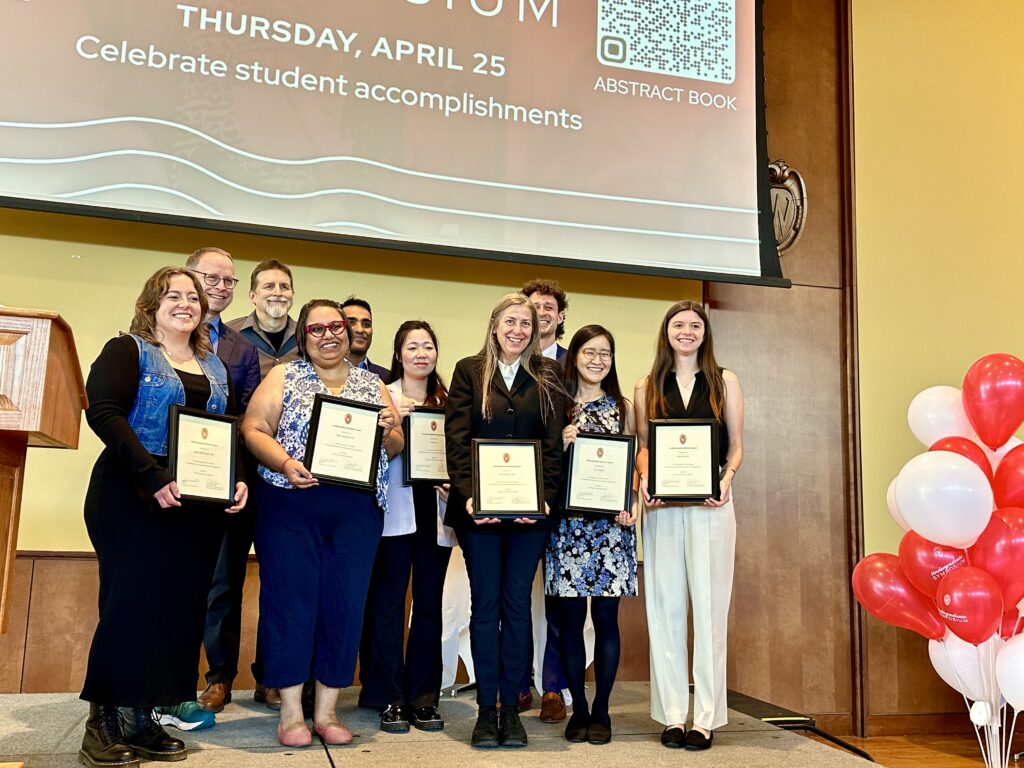
Physics students inducted into Phi Beta Kappa
This post is modified from one originally published by University Communications
On Saturday, April 13, physics students Will Cerne and William Griffin were among the 168 University of Wisconsin–Madison Letters & Science undergraduates inducted to the Phi Beta Kappa (ΦΒΚ) academic society. The induction ceremony was held at Varsity Hall in Union South with 350 attending.
In addition to the induction of new undergraduate members, the ceremony also honored four individuals for their contributions to UW–Madison, including Jimena González, a member of the UW–Madison chapter of the Edward A. Bouchet Society and a PhD candidate in Physics (observational cosmology). González accepted one of ΦΒΚ’s graduate student induction invitation.
UW–Madison’s ΦΒΚ chapter, founded in 1899, seeks to honor students who rigorously explore the sciences, arts and humanities.
L&S Dean Eric M. Wilcots led the opening procession and welcome. Chapter President David W. Johnson, economics, hosted the celebration’s 125th year of the founding of the UW–Madison chapter of Phi Beta Kappa. Special guest and president of the national Phi Beta Kappa Society Peter Quimby PhD’99 presented the history of ΦΒΚ. ΦΒΚ stands for philosophia biou kubernetes, which translates to “the love of wisdom is the helmsman of life.”
Inductees excel in all areas of study, ranging from physics to anthropology, and they must have a cumulative GPA of 3.80 or above and meet strenuous math, language, and breadth requirements.
A committee of faculty and staff review the student record for nomination into the chapter. Inductees have a love for learning in multiple areas of study at the intermediate and advanced levels, exploring far beyond their major area of study at UW–Madison.
Ellen Zweibel named Hilldale Professor
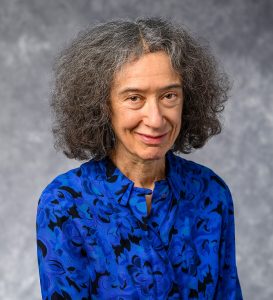
Five members of the University of Wisconsin–Madison faculty, including astronomy and physics professor Ellen Zweibel, have received Hilldale Professorships.
Hilldale Professorships are given to faculty members who excel in scholarly activity, have records of outstanding research or creative work, and show promise of continued productivity. Recipients receive a salary increase in addition to funding that may be used for research support and teaching release. Appointments are for five years with the possibility of renewal until the individual leaves the university or retires.
Zweibel’s work in theoretical astrophysicist specializes in plasma astrophysics and focuses on evolution of astrophysical magnetic fields, interstellar astrophysics, star formation, cosmic rays and stellar physics.
Tulika Bose honored with Vilas Distinguished Achievement Professorship
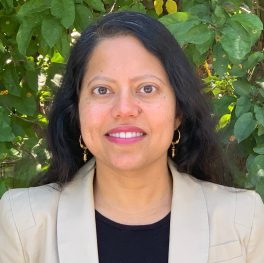
Sixteen professors, including physics professor Tulika Bose, were named to Vilas Distinguished Achievement Professorships, an award recognizing distinguished scholarship as well as standout efforts in teaching and service. The professorship provides five years of flexible funding — two-thirds of which is provided by the Office of the Provost through the generosity of the Vilas trustees and one-third provided by the school or college whose dean nominated the winner. The awards are supported by the estate of professor, U.S. Senator and UW Regent William F. Vilas (1840-1908).
Jim Reardon wins WISCIENCE Lillian Tong Teaching Award
Each year, the University of Wisconsin–Madison recognizes outstanding academic staff members who have excelled in leadership, public service, research and teaching. These exceptional individuals bring the university’s mission to life and ensure that the Wisconsin Idea extends far beyond the campus and the state. Ten employees won awards this year, including Dr. Jim Reardon, Director of Undergraduate Program with the department of physics.
Jim Reardon’s love of running and his excellence as a physics instructor recently came together in the classroom in a big way with Physics 106: The Physics of Sports, a course he developed and now teaches. The new course applies physical principles to competitive sports, helping students better understand athletic performance. It’s proven exceptionally popular, attracting almost 140 students in only its third semester.
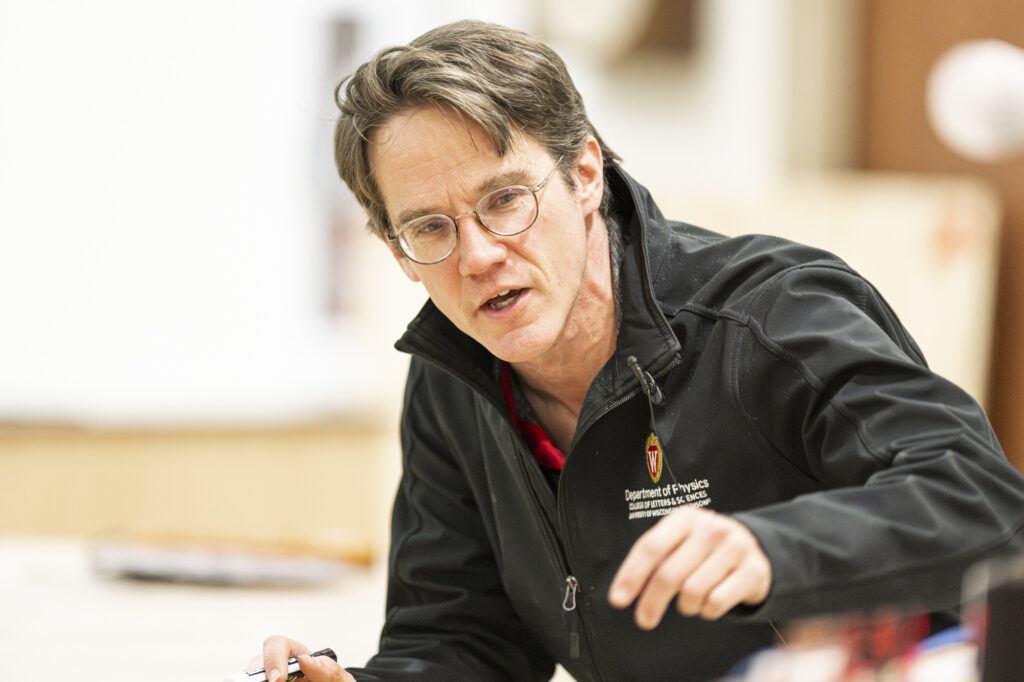
Reardon’s expertise at course development, his mastery at instruction and his exemplary support of teaching assistants have made him indispensable to the Physics Department. As director of the undergraduate program, he implemented standardized assessments in the department’s large introductory courses. This provided a baseline for successful course modifications and allowed nationwide peer assessment comparisons. As the administrator of the teaching assistant program, Reardon expertly matches the strengths of TAs with the needs of the department.
Reardon is no less valued in the classroom. Students routinely give him the highest of marks. Writes one, “I have never seen a professor or teacher work so effectively and patiently to ensure his students understood the information.”
♦
“Jim is unique in his broad and ready grasp of the subject matter combined with a passion for teaching and making sure that ALL students have access to that subject matter.”
— Sharon Kahn, graduate program manager, Department of Physics
Bringing the Quantum to the Classical: A Hybrid Simulation of Supernova Neutrinos
By Daniel Heimsoth, Physics PhD student
Simulating quantum systems on classical computers is currently a near-impossible task, as memory and computation time requirements scale exponentially with the size of the system. Quantum computers promise to solve this scalability issue, but there is just one problem: they can’t reliably do that right now because of exorbitant amounts of noise.
So when UW–Madison physics postdoc Pooja Siwach, former undergrad Katie Harrison BS ‘23, and professor Baha Balantekin wanted to simulate neutrino evolution inside a supernova, they needed to get creative.
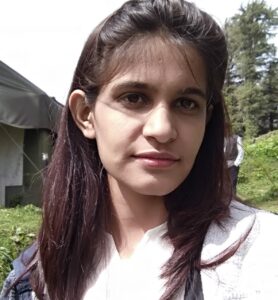
Their focus was on a phenomenon called collective neutrino oscillations, which describes a peculiar type of interaction between neutrinos. Neutrinos are unique among elementary particles in that they change type, or flavor, as they propagate through space. These oscillations between flavors are dictated by the density of neutrinos and other matter in the medium, both of which change from the core to the outer layers of a supernova. Physicists are interested in how the flavor composition of neutrinos evolve in time; this is calculated using a time evolution simulation, one of the most popular calculations currently done on quantum computers.
Ideally, researchers could calculate each interaction between every possible pair of neutrinos in the system. However, supernovae produce around 10^58 neutrinos, a literally astronomical number. “It’s really complex, it’s very hard to solve on classical computers,” Siwach says. “That’s why we are interested in quantum computing because quantum computers are a natural way to map such problems.”
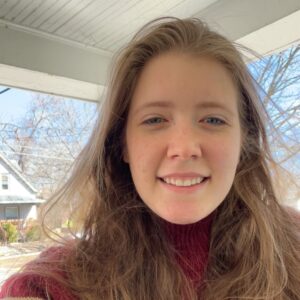
This naturalness is due to the “two-level” similarities between quantum computers and neutrino flavors. Qubits are composed of two-level states, and neutrino flavor states are approximated as two levels in most physical systems including supernovae.
In a paper published in Physical Review D in October, Siwach, Harrison, and Balantekin studied the collective oscillation problem using a quantum-assisted simulator, or QAS, which combines the benefits of the natural mapping of the system onto qubits and classical computers’ strength in solving matrix equations.
In QAS, the interactions between particles are broken down into a linear combination of products of Pauli matrices, which are the building blocks for quantum computing operations, while the state itself is split into a sum of simpler states. The quantum portion of the problem then boils down to computing products of basis states with each Pauli term in the interaction. These products are then inputted into the oscillation equations.
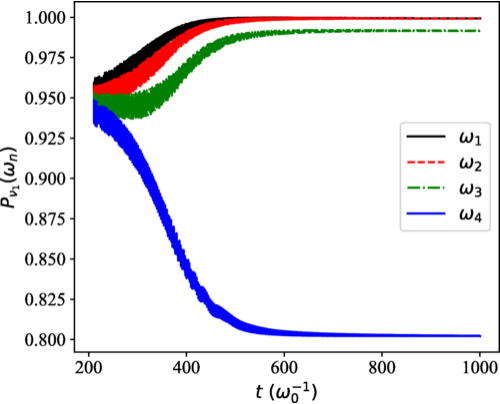
“Then we get the linear-algebraic equations to solve, and solving such equations on a quantum computer requires a lot of resources,” explains Siwach. “That part we do on classical computers.”
This approach allows researchers to use the quantum computers only once before the actual time evolution simulation is done on a classical computer, avoiding common pitfalls in quantum calculations such as error accumulation over the length of the simulation due to noisy gates. The authors showed that the QAS results for a four-neutrino system match with a pure classical calculation, showcasing the power of this approach, especially compared to a purely quantum simulation which quickly deviates from the exact solution due to accumulated errors from gates controlling two qubits at the same time.
Still, as with any current application of quantum computers, there are limitations. “There’s only so much information that we can compute in a reasonable amount of time [on quantum computers],” says Siwach. She also laments the scalability of both the QAS and full quantum simulation. “One more hurdle is scaling to a larger number of neutrinos. If we scale to five or six neutrinos, it will require more qubits and more time, because we have to reduce the time step as well.”
Harrison, who was an undergraduate physics student at UW–Madison during this project, was supported by a fellowship from the Open Quantum Initiative, a new program to expand undergrad research experiences in quantum computing and quantum information science. She enjoyed her time in the program and thinks that it benefits students looking to get involved in research in the field: “I think it’s really good for students to see what it really means to do research and to see if it’s something that you’re capable of doing or something that you’re interested in.”
